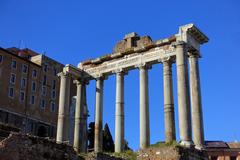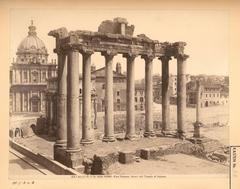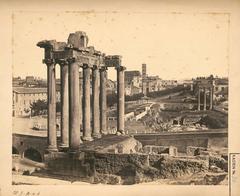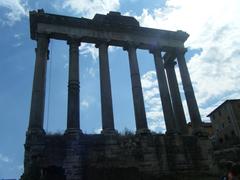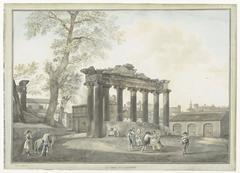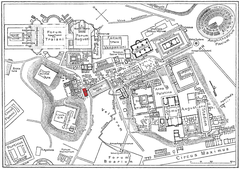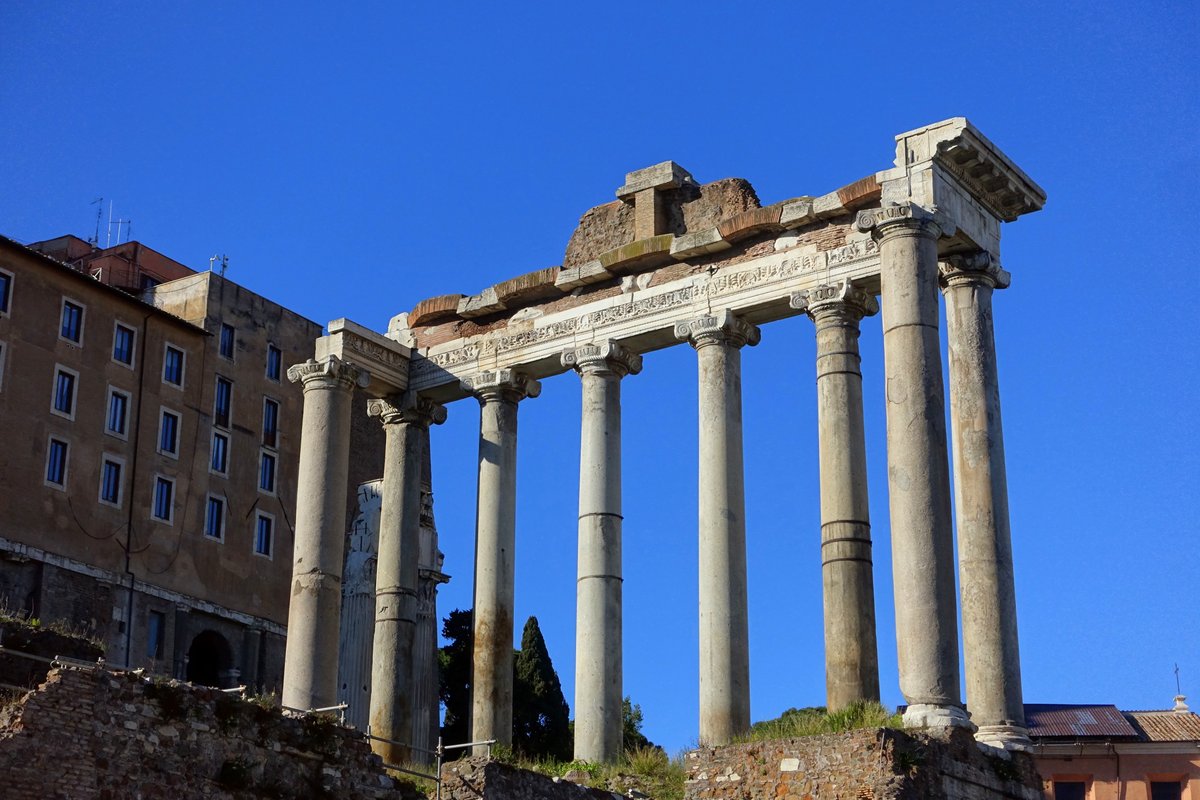
Temple of Saturn, Rome: Visiting Hours, Tickets, and Historical Significance
Date: 14/06/2025
Introduction
The Temple of Saturn stands as one of the most iconic monuments in Rome’s ancient heart, embodying the religious, political, and economic life of the Roman Republic and Empire. Situated at the western end of the Roman Forum beneath the Capitoline Hill, this temple was dedicated to Saturn—the god of agriculture and wealth—and served as the treasury (Aerarium Saturni) of ancient Rome. Its enduring ruins, particularly the impressive colonnade, are not only a testament to Roman architectural achievement but also a powerful symbol of the city’s evolving identity.
This guide provides a detailed overview of the Temple of Saturn’s history, architectural features, cultural significance, and essential information for visitors, including current visiting hours, ticketing options, accessibility, guided tours, and nearby attractions. Whether you are a history enthusiast, architecture lover, or first-time traveler to Rome, this article will help you make the most of your visit.
Contents
- Historical Background
- Origins and Early Construction
- Rebuilding and Architectural Evolution
- Religious and Civic Functions
- Role in Festivals and the Roman Calendar
- Decline and Preservation
- Architectural Features
- Columns and Portico
- Podium and Cella
- Decorative Elements and Inscriptions
- State Treasury and Civic Function
- Visiting the Temple of Saturn Today
- Visiting Hours and Tickets
- Accessibility
- Guided Tours and Special Events
- Nearby Attractions
- Practical Travel Tips
- Frequently Asked Questions (FAQ)
- Conclusion and Recommendations
- Sources
Historical Background
Origins and Early Construction
The Temple of Saturn is among the oldest structures in the Roman Forum, with its initial dedication dating back to 497 BCE. According to ancient tradition, its foundation is linked to the transition from monarchy to republic, with some sources crediting King Tarquinius Superbus and others, the consul Titus Larcius, for its construction. The site may have previously hosted the Ara Saturni, an altar to Saturn, indicating the area’s deep religious roots.
The earliest temple featured a rectangular plan and a colonnaded façade, constructed with local tufa and wood—materials typical of early Roman architecture. Its prominent position at the entrance to the Forum underscored its centrality to both civic and religious life.
Rebuilding and Architectural Evolution
Throughout its history, the Temple of Saturn was repeatedly rebuilt due to fire, earthquake, and the city’s changing fortunes. The most significant reconstructions occurred:
- In the 4th century BCE, after severe damage.
- In 42 BCE, when Lucius Munatius Plancus oversaw a major restoration, giving the temple its current recognizable colonnade.
- During the reign of Diocletian in the late 3rd and early 4th centuries CE, resulting in the marble-faced podium and granite columns visible today.
Subsequent repairs and adaptations enhanced the temple’s durability and grandeur, with each phase reflecting the prevailing architectural influences and state priorities.
Religious and Civic Functions
The Temple of Saturn was both a spiritual center—housing a cult statue of the god Saturn—and the repository for the Aerarium, Rome’s state treasury. The treasury safeguarded the city’s wealth, official documents, treaties, and military standards, making the temple a focal point of Roman governance.
The temple’s religious significance was manifested in the rituals and festivals held here, especially Saturnalia, a week-long celebration marked by feasting, gift-giving, and the symbolic unbinding of Saturn’s statue, representing societal renewal and abundance.
Role in Festivals and the Roman Calendar
Saturnalia, Rome’s most popular festival, began with sacrifices at the temple and included public banquets, role reversals, and widespread merriment. The temple also played a role in the civic calendar, with officials using its steps for public announcements, including the start of each new month.
Decline and Preservation
With the rise of Christianity in the late Roman Empire, the temple lost its religious function. However, its architectural remains survived and were later excavated during the 18th and 19th centuries. Today, the eight iconic Ionic columns and marble podium are preserved as part of the Roman Forum archaeological park, offering visitors a tangible link to Rome’s ancient glory.
Architectural Features
Columns and Portico
The most distinctive feature of the Temple of Saturn is its surviving portico, composed of eight Ionic columns—six at the front and two on the sides—each rising about 12 meters. Crafted from grey Egyptian granite with white marble capitals, these columns support an entablature inscribed with a Latin dedication referencing the temple’s restoration (myromepass.com).
Podium and Cella
The temple rests on a high podium, approximately 22 by 40 meters, built from tufa and travertine and later faced with marble. This elevated base was both a practical and symbolic feature, emphasizing separation between the sacred and the ordinary. Behind the portico, the cella (inner chamber) housed the cult statue and the treasury, its walls once adorned with marble and reliefs depicting mythological and agricultural scenes.
Decorative Elements and Inscriptions
The entablature’s Latin inscription translates to “The Senate and People of Rome restored [this temple] consumed by fire,” reflecting the temple’s civic importance. Decorative friezes and pedimental sculptures depicted motifs of prosperity, such as wheat sheaves and garlands, in keeping with Saturn’s role as a god of agriculture.
State Treasury and Civic Function
Unusually for a Roman temple, the Temple of Saturn’s substructure housed the Aerarium, the state treasury. Secured beneath the cella, this chamber was vital for the administration of Rome’s financial and political affairs, and bronze tablets with official records were stored here (myromepass.com).
Visiting the Temple of Saturn Today
Visiting Hours and Tickets
The Temple of Saturn is accessible as part of the Roman Forum archaeological site, which is open year-round except for major holidays (December 25 and January 1). Opening hours generally run from 8:30 am to one hour before sunset, varying seasonally:
- March–August: 8:30 am – 7:15 pm
- September: 8:30 am – 7:00 pm
- October: 8:30 am – 6:30 pm
- November–February: 8:30 am – 4:30 pm
Last entry is usually one hour before closing (official site).
Tickets:
Entry to the Temple of Saturn is included with the Roman Forum ticket, which also covers the Colosseum and Palatine Hill.
- Adult: Approximately €16–€18
- Reduced/Youth: Discounts for EU citizens aged 18–25
- Children under 18: Free
- Combined tickets and Omnia Card: For convenience and savings on multiple attractions (official site)
Booking:
Advance online booking is strongly recommended, especially during peak tourist seasons. E-tickets can be scanned from your smartphone; select an entry time when booking online.
Accessibility
While the Roman Forum contains uneven ancient paths and some steep gradients, there are accessible routes and ramps where possible. Visitors with mobility needs should wear sturdy footwear and check with staff at the entrance or book guided tours designed for accessibility (romaexperience.com).
Guided Tours and Special Events
Guided tours—both in-person and via audio guide—are available and highly recommended for a deeper understanding of the temple’s history and significance. Many tours include expert insights into the architecture and festivals associated with the Temple of Saturn. Look for special events and seasonal activities, especially around the time of Saturnalia (getyourguide.com).
Nearby Attractions
While visiting the Temple of Saturn, consider exploring other highlights of the Roman Forum:
- Arch of Septimius Severus
- Rostra
- Basilica Julia
- Temple of Vespasian and Titus
- House of the Vestals
- Capitoline Hill Museums
The Colosseum and Piazza Venezia are also within easy walking distance (nomadepicureans.com).
Practical Travel Tips
- Best Times to Visit: Early mornings and late afternoons offer fewer crowds and optimal lighting for photos.
- Facilities: Restrooms and drinking fountains are available within the Forum and on Palatine Hill.
- Food/Drink: No restaurants inside the Forum; bring water and snacks or plan to eat before/after your visit.
- Sun Protection: The site offers little shade—bring a hat, sunscreen, and water, especially in summer.
- Security: Expect security checks at entry. Large bags may not be allowed; no luggage storage on site.
- Dress Code: Wear comfortable, sturdy shoes for walking on uneven surfaces.
Frequently Asked Questions (FAQ)
Q: What are the visiting hours for the Temple of Saturn?
A: The temple is accessible during Roman Forum opening hours, generally from 8:30 am to sunset, with seasonal variations. Closed December 25 and January 1 (official site).
Q: How much do tickets cost?
A: Standard Roman Forum tickets (including the Temple of Saturn) are about €16–€18 for adults, with discounts for youth and free entry for children under 18.
Q: Can I buy tickets on-site?
A: Yes, but online booking is advised to avoid queues and ensure your preferred time slot.
Q: Is the Temple of Saturn accessible for people with disabilities?
A: Parts of the Forum, including paths near the temple, are accessible, but the terrain may be challenging. Check accessibility details before your visit.
Q: Are guided tours available?
A: Yes, numerous guided and audio tours are available, enriching your visit with historical context.
Q: Is photography allowed?
A: Yes, photography is permitted. The best lighting is in the early morning or late afternoon.
Q: Are there restrooms and water fountains?
A: Yes, facilities are available within the Forum complex.
Conclusion and Visitor Recommendations
The Temple of Saturn is a profound symbol of ancient Rome’s religious devotion, civic administration, and architectural innovation. Its enduring columns and well-preserved podium invite visitors to step into the world of the Roman Republic and Empire, offering a direct connection to the city’s storied past. Exploring this site, especially as part of a broader tour of the Roman Forum, provides invaluable insights into the rituals, festivals, and governance that shaped Western civilization.
To maximize your visit:
- Check current hours and book tickets in advance via the official Parco Colosseo website.
- Consider a guided tour or audio guide to enhance your understanding.
- Wear comfortable shoes and plan for several hours to explore the Forum and nearby attractions.
- Use digital resources like the Audiala app for immersive audio tours and travel tips.
Stay updated on Rome’s archaeological sites and travel advice by following dedicated platforms and social media channels. Your exploration of ancient Rome’s rich heritage begins at the Temple of Saturn!
Sources
- Temple of Saturn in Rome: History, Visiting Hours, Tickets, and Travel Tips (Roman Forum official website)
- Temple of Saturn in Rome: Visiting Hours, Tickets & Architectural Highlights (MyRomePass)
- The Temple of Saturn in Rome: Visiting Information and Cultural Significance (Roman Mythology Worldwide)
- Temple of Saturn Visiting Hours, Tickets, and Tips for Your Visit to Rome’s Historical Sites (Nomadepicureans)
- Visiting the Roman Forum and Palatine Hill (Travel with Kinsley)
- Temple of Saturn: Facts & History (Madain Project)
- Guide to the Roman Forum (Roma Experience)
- Temple of Saturn Rome Tours (GetYourGuide)
- Roman Forum: Visitor’s Guide (Toorists)
